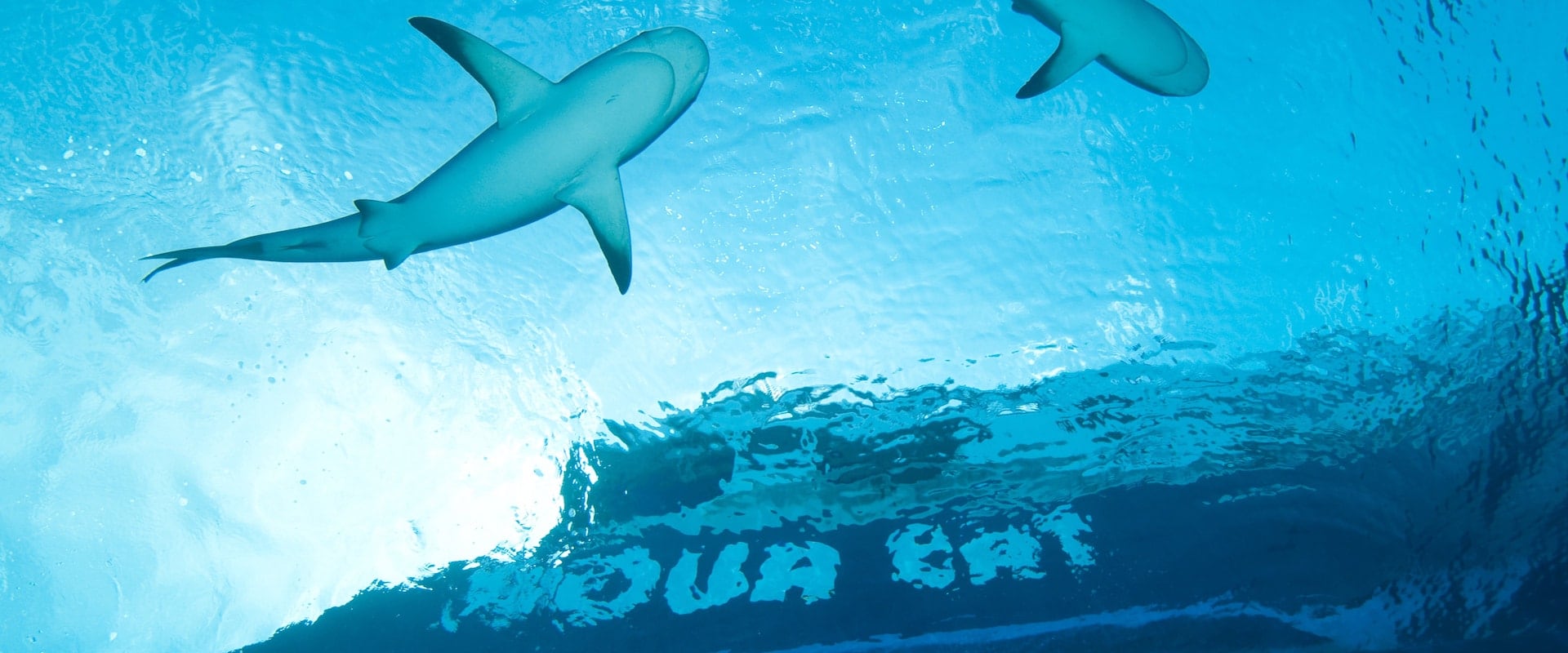Diving in the Bahamas
With over 700 practically untouched islands, scuba diving in the Bahamas is most enjoyable on a liveaboard. Find Spanish galleons, blue holes, underwater caves and caverns bustling with marine life both large and small. Warm, clean waters bring a variety of sharks, whales sharks, groupers, rays, turtles and dolphins.
Scuba Diving in the Bahamas, a group of 700 pristine islands and nearly 2,500 cays where the Western Atlantic Ocean meets the Caribbean Sea, is to experience scuba diving like no where else in the world. Find sunken Spanish galleons and proud maritime history, tidal blue holes, underwater caves and caverns and bustling reefs teeming with diverse marine life and big animal encounters with sharks and dolphins.
Bahamas scuba diving exposes you to the island nation’s famous warm, clean waters and prolific underwater habitat. Because the islands and dive sites can be spread out quite far, scuba diving liveaboards may be the best way to experience the underwater worlds of the Bahamas. Many of the top dive sites are too far to access by a single day boat tour.
7 Liveaboards in Bahamas
Explore all liveaboards
Dolphin Dream
Bahamas-
- from $ 527 / day
- 9.6 Exceptional
- 8reviews

Bahamas Aggressor II
Bahamas-
- from $ 301 / day

Bahamas Aggressor
Bahamas-
- from $ 298 / day
- 8.6 Fabulous
- 95reviews

Aqua Cat
Bahamas-
- from $ 298 / day
- 9.3 Superb
- 86reviews

Cat Ppalu
Bahamas-
- from $ 263 / day
- 9.2 Superb
- 13reviews

Blackbeards Sea Explorer
Bahamas-
- from $ 164 / day
- 9.3 Superb
- 77reviews
Diving in the Bahamas FAQ
What marine life can I expect to see in the Bahamas?
Scuba diving in the Bahamas has become a number-one destination for big animal encounters with each dive site bringing an opportunity to come face-to-face with 600 pound Goliath Grouper, 40 foot long whale sharks, spotted-eagle rays with wingspans of 6 feet and a variety of curious shark species. Vibrant coral reefs and walls are just the beginning as Bahamas dive sites will also expose you to a large variety of fish and invertebrates, conch, dolphins, rays and sea turtles as well as the invasive lionfish. The Bahamas is famous for its Hammerheads, bulls, tiger, lemon and reef sharks and became a shark sanctuary in 2011. “The March of the Spiny Lobsters” takes place a few times each year to divers delight. And no scuba diving trip to the Bahamas is complete without spotting the Nassau Grouper — the national fish of the Bahamas.
What are the best dive sites in the Bahamas?
EXUMA CAYS: - Scuba diving in the Exuma Cays will reward divers with an intriguing combination of shallow reefs and colorful walls. The Exumas are an archipelago of 365 cays and islands 35 miles southeast of Nassau. Considered a unique geographical feature, diving in the Bahamas offers the only tidal blue hole experiences in the world such as the Angelfish Blue Hole off of Stocking Island where the crystal blue shallow waters turn to dark-turquoise almost instantly as the seafloor drops to 100 feet. At other Exuma dive sites, swift drifts may carry you along the vast beds of coral reefs bustling with large schools of brightly-colored fish. Find sharks lurking about while diving Amberjack Reef and don’t miss the Austin Smith wreck, the 400-foot Mystery Cave blue hole or Thunderball Grotto named for the James Bond film shot on location.
TIGER BEACH: - This shallow sand flat is the most reliably consistent spot in the Bahamas for shark encounters. An hour off the coast of the West End of Grand Bahama Island, this rarely visited area of the Bahamas allows for scuba diving exploration and passive shark observation at a relaxed pace. The shallow waters allow for great photo ops of Caribbean Reef sharks, Lemon Sharks, Hammerheads, Bull sharks, Oceanic whitetips and, of course, the Tiger sharks for which the dive site is named. Divers often encounter dolphins as well. Extra weight is often recommended on this dive to help divers anchor to the sandy bottom without churning it up and obstructing the view or rousing the sharks. Sharks are not an immediate threat to humans, however, they deserve a high level of respect and inexperienced divers may or may not be ready for the rush that comes with so many circling sharks.
AUSTIN SMITH WRECK: - Every wreck dive has a tale to tell. The Austin Smith, named for a Bahamian marine killed in a 1980 attack, was a 90-foot Bahamian Defense Force patrol decommissioned in 1995 and destined to become an artificial reef and dive destination off the coast of San Salvador. Unfortunately for San Salvador, the ship sank while being towed and now rests in 60 feet of water on a flat coral bottom off the coast of the Exuma Cays. Now abundant with marine life and astounding regrowth of brilliant corals and delicate sea fans and sponges, visibility typically reaches more than 100 feet. Marine life is expected to continue to thrive in the area thanks to the accidental mishap with the Austin Smith. Diving the Austin Smith is only possible by dive boat and mooring buoys help prevent any damage to the beautiful dive site by boat anchors.
What's the best time to dive in the Bahamas?
The light blue waters of the Bahamas create a relaxing scuba diving experience. At 80 degrees Fahrenheit year-round and 340 days of annual sunshine, there is no bad time to explore the beautiful Bahamas, however, the summer months from June to October are considered hurricane season but do also ordinarily see the calmest seas. The dry season months from November to May could have slightly choppier waters but are considered the best dive season. Those susceptible to cold may enjoy visiting during the months of June to August when, generally, no wet suit is needed because of the warm water temperatures. February and March are most successful for bull and tiger shark sighting while April and May are most common for Oceanic whitetips.
What's the recommended experience level for diving in the Bahamas?
Scuba Diving in the Bahamas is enjoyable for all experience levels and has no minimum dive requirements. Prior drift diving experience is helpful, but not necessary. Many dive sites are customizable for divers of any ability. A Bahamas liveaboard is one way to ensure you’re scuba diving with guests of comparable ability — your cruise ship divemasters will be able to separate divers into groups to ensure every guest maximizes their dive time on holiday in the Bahamas. Nitrox is also available from liveaboard ships as well as by certified dive shops on the island.
How do I get to the Bahamas?
The Lynden Pindling International Airport, located in the capital city of Nassau, is the largest airport. Freeport Grand Bahama International Airport on Grand Bahama and the George Town International Airport on Exuma also both receive several international flights. More than 50 smaller, domestic airports are scattered throughout the island cluster. Flights are most commonly available on Air Canada, Copa Airlines, British Airways and Caribbean Airlines as well as many American carriers such as American Airlines and JetBlue. Flights directed through the United States commonly leave from Atlanta, Georgia; Ft. Lauderdale, Florida; or Miami, Florida.
7 Liveaboards in Bahamas
Explore all liveaboards
Dolphin Dream
Bahamas-
- from $ 527 / day
- 9.6 Exceptional
- 8reviews

Bahamas Aggressor II
Bahamas-
- from $ 301 / day

Bahamas Aggressor
Bahamas-
- from $ 298 / day
- 8.6 Fabulous
- 95reviews

Aqua Cat
Bahamas-
- from $ 298 / day
- 9.3 Superb
- 86reviews

Cat Ppalu
Bahamas-
- from $ 263 / day
- 9.2 Superb
- 13reviews

Blackbeards Sea Explorer
Bahamas-
- from $ 164 / day
- 9.3 Superb
- 77reviews











